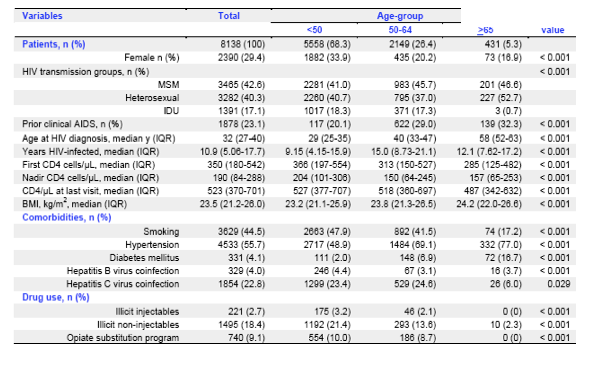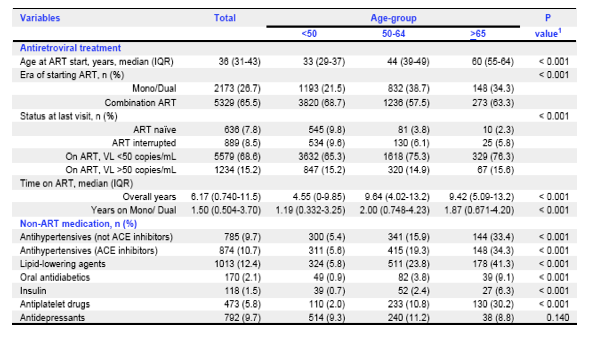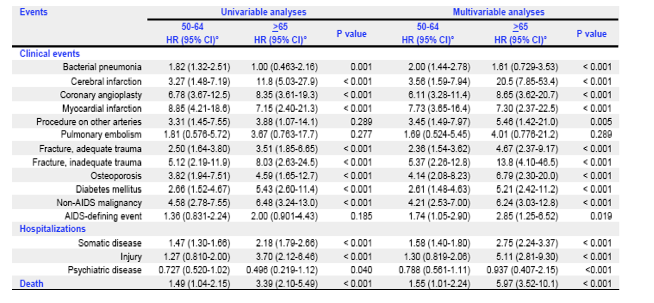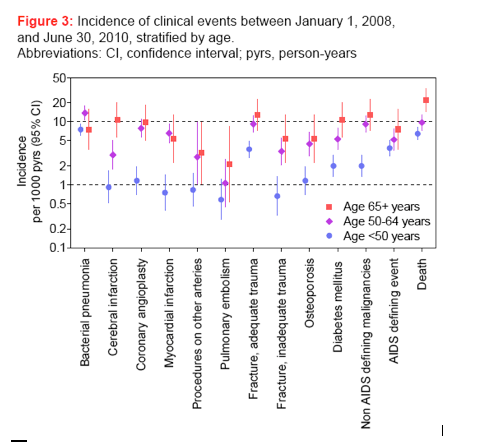 |
 |
 |
| |
Aging and Non-HIV-associated Co-morbidity in HIV+ Persons: The SHCS - pdf attached
|
| |
| |
Download the PDF now
Reported by Jules Levin
CROI 2011 March 2 Boston
B Hasse1, B Ledergerber1, M Egger2, P Vernazza3, H Furrer4, M Battegay5, B Hirschel6, M Cavassini7, E Bernasconi8, Rainer Weber*1, and Swiss HIV Cohort Study
1Univ Hosp Zurich, Univ of Zurich, Switzerland; 2Inst for Social and Preventive Med, Univ of Bern, Switzerland; 3Cantonal Hosp, St Gallen, Switzerland; 4Univ Hosp Bern, Univ of Bern, Switzerland; 5Univ Hosp Basel, Switzerland; 6Univ Hosp Geneva, Switzerland; 7Univ Hosp Lausanne, Switzerland; and 8Regional Hosp Lugano, Switzerland
Antiretroviral therapy and non-HIV medication: A total of 6177 of 8138 (76%) participants were taking ART, and 5579 of the 6177 (90%) participants had an undetectable viral load at the last cohort visit in the reference period (Table 1B). 2458 of 8138 (30.2%) participants had at least one non-HIV comedication. Figure 2 shows the % of participants with their respective numbers of non-HIV medication stratified by age.
AUTHOR CONCLUSIONS:
Non-HIV co-morbidities, particularly diabetes mellitus, cardiovascular disease, non-AIDS malignancies, and osteoporosis, become increasingly important in HIV care, and most of these “non-HIV” events are frequently age-related. (smoking rates were 50% in patients so there are lifestyle factors contributing)
Background: The population of HIV+ individuals with access to ART is aging. Improved survival of HIV infection leads to changing patterns of morbidity and mortality. We studied the epidemiology of non-HIV-associated diseases in the Swiss HIV Cohort Study (SHCS), particularly in persons >50 years.
Methods: The SHCS is a prospective observational cohort established in 1988 with continuous enrolment. We analyzed the incidence of clinical events/1000 person-years from October 1, 2008 (when a new questionnaire on non-HIV clinical events was introduced) to March 31, 2010. Differences across age groups were assessed with Cox regression.
Results: Of 8105 participants, 7746 (96%) had complete data for analyses and contributed to 20,292 visits; 1990 (26%) individuals were >50 years (older) and 378 (5%) were >65 years (elderly). Median duration of HIV infection was 10.8 years (IQR 5.1 to 17.6); 22.9% had prior clinical AIDS; nadir CD4 count was 189 (84 to 287); and latest CD4 count was 518 [369 to 696] cells/mL. Of persons <50, 50 to 65, and >65 years, respectively, 10.0, 3.9, and 2.1% were ART-naive; 17.7, 8.8, and 5.3% were not on ART at the latest visit, 67.8, 75.6, 80.1% were on stable ART (HIV-1 RNA <50 copies/mL); and 14.5, 15.6, 14.6% had experienced virologic failure; 30.8, 47.7, and 69.0% were on co-medication in addition to ART.
We observed 512 new clinical events in the reference period, including 121 bacterial pneumonias, 29 myocardial infarctions, 20 strokes, 34 incident diabetes mellitus, 67 incidents of trauma to associated fractures, 23 fractures without adequate trauma, and 45 non-AIDS malignancies. The figure depicts the incidence/1000 person-years of new clinical events and deaths during the observation period. Incidence rates for clinical AIDS (hazard ratio 1.5, 95%CI 1.0 to 2.2) and death (1.8, 1.2 to 2.8) were elevated for persons aged >50 years (compared with <50). Also, hazard ratios for bacterial pneumonia, 1.6 (1.1 to 2.3); stroke, 2.8 (1.1 to 6.7); myocardial infarction, 5.0 (2.3 to 11.0); diabetes mellitus, 2.9 (1.5 to 5.6); bone fractures associated with trauma, 1.8 (1.1 to 2.9); bone fractures with assumed inadequate trauma, 5.1 (2.1 to 12.5); and non-AIDS-defining malignancies, 6.6 (3.5 to 12.4); were significantly higher for older individuals (all p <0.05).
Conclusions: Non-HIV co-morbidities, particularly diabetes mellitus, cardiovascular disease, non AIDS-defining malignancies, and osteoporosis, become increasingly important in HIV care, and are frequently age-related.
I recall on the poster the smoking rate was much higher, 80%, viewers were discussing that, but in this online version smoking rates are much lower but still a potential confounder!!
Table 1A: Clinical baseline characteristics of 8138 HIV-seropositive cohort participants, stratified by age

Of note below in Table 1B after age 50 a lot of patients were taking medications for comorbidities, the percent increased quite a lot compared to patients <50 yrs old: 15-20% of patients were taking antihyperintensives & lipid lowering agents; and for patients >65 yrs old the percent of patients taking these extra medications increased quite a lot more!
Table 1B: Antiretroviral therapy and non-HIV medication in 8138 HIV-seropositive cohort participants, stratified by age

Of note in Table 2 are high rates of fractures & osteoporosis, and non-AIDS malignancies, psych disease
Table 2: Uni- and multivariable hazard ratios for clinical events, hospitalizations, and death, from January 1, 2008, until June 30, 2010, stratified by age


|
| |
|
 |
 |
|
|